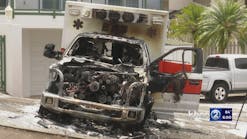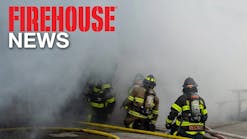OH Firefighters Find Homemade Safety Solutions for Pandemic
By Sean McDonnell
Source Akron Beacon Journal
Editor's note: Find Firehouse.com's complete coverage of the COVID-19 pandemic here.
Out of adversity often comes innovation.
As fire departments continue to battle coronavirus, Cuyahoga Falls firefighters are channeling their inner MacGyver and building devices to do extra decontamination.
"This is an unseen enemy," Falls Fire Lt. Rick Malak said. "You have to be hyper vigilant about everything."
Assistant Chief Chris Martin said the department started ordering masks, gowns, gloves and other necessary protective gear to stockpile in preparation for coronavirus. It also started adding extra cleaning and decontamination to its arsenal.
Like protective equipment, medical cleaning equipment was on back order. As they waited for items to become available, firefighters started seeing what they could make on their own.
"Most of the guys in the fire department have some mechanical intuition, " Lt. Tom Carano said. "We all like to tinker."
Tinker away they did, and now the department has a wide array of UV-light based units, both bought and built, to decontaminate rooms and items.
Carano said they're using the UV lights in addition to their normal decontamination protocols. UV light is not clinically proven to kill coronavirus yet but has been shown to kill most other viruses. Similar devices are used in hospitals to sanitize rooms, and smaller devices are available commercially to clean smaller objects, although they have been hard to buy recently.
"In light of the virus, every little thing we can do extra makes our city that much safer," he said.
The science behind UV light, Carano said, is that it stops cellular replication, killing viruses and bacteria with prolonged exposure. UV-light is what gives people sunburns, but a lot more of it is needed for decontamination, so the department uses special light bulbs.
To clean the backs of ambulances and rooms in the fire station, Carano wired a timer into five floor lamps, and outfitted them with UV-light bulbs. The lamps are left to run for about half an hour and can cover up to 500 square feet of space.
The same bulbs can go into the decontamination boxes Carano made to use for smaller items, including firefighters' masks, tablets they use on the job or even their cell phones. The rubber containers, lined with reflective material, have hooks on their lids so masks can be dangled in front of the light and hit on all sides.
The department bought small containers that look almost like lunch boxes that do the same thing.
Carano said they also bought a lamp designed for decontamination. The medical lamp cost about $1,000, and it broke the next day. Carano made five lamps for about half the cost.
Using UV light also avoids having to use chemicals. N95 masks, for instance, can be damaged if they're cleaned with some chemicals. Carano said the masks use a static charge, which attracts particles like a magnet. Using a chemical solution could remove that charge.
Every patient gets a new mask they keep. The N95 masks firefighters use are in high-demand, and the UV light can give them a way to clean them in between calls, Carano said.
"Right now, they're in short supply, so we're doing everything we can to make them last longer." Carano said.
Staying clean isn't just important for patients, it's also important for paramedics themselves. Malak said in many cases, they're face-to-face with people who may have or are confirmed to have coronavirus when they respond in an ambulance.
"We have to sit within a couple of feet of the patient for the entire trip," Malak said.
To help mitigate risk, Malak built onto the existing exhaust systems in each ambulance and created a way to expel air from patients out the door, instead of toward paramedics. Using plumbing parts and shop-vac tubes, he said it's a cheap way to keep the firefighters safe and healthy.
"In effect, they're not exhaling in the back of the ambulance," Malak said.
For added decontamination, the department also purchased a "disinfectant bomb" that will fog the back of the ambulances with a cleaning solution. The bomb is used every few weeks in addition to germ-killing wipes used after each call.
Martin said the increased decontamination, both purchased and made in-house, has been an ongoing effort as the department stays prepared for the coronavirus. Some of the items, like the disinfectant bomb, will be used for years to come, and the next ambulance coming to the department already has UV lights built in.
Staying ahead of the virus hasn't come cheap. Fire Chief Fred Jackson said the department has spent tens of thousands of dollars more than it normally would.
The need for more protective equipment and rising prices for the items have contributed to the increased spending, he said.
When Ebola hit the country, Jackson said the department learned to be prepared. It has some supplies stockpiled from then, and will stockpile any back-ordered supplies they order now but get later.
At their current rate of use, Martin said they'll have enough personal protective equipment for the current wave of coronavirus cases. As the supplies they ordered come in, they can stock up and prepare for potential second or third waves. He said the only true marker that the crisis is over is when the vaccine is available..
"We've gotten through the sprint, now we're in the marathon," Martin said. "We still need to be as far ahead of this as we can."
Reach Akron Beacon Journal reporter Sean McDonnell at [email protected] or 330-996-3186.
———
©2020 the Akron Beacon Journal (Akron, Ohio)
Visit the Akron Beacon Journal (Akron, Ohio) at www.ohio.com
Distributed by Tribune Content Agency, LLC.






